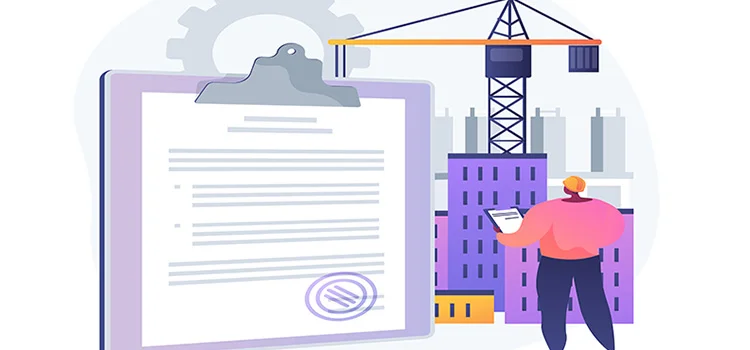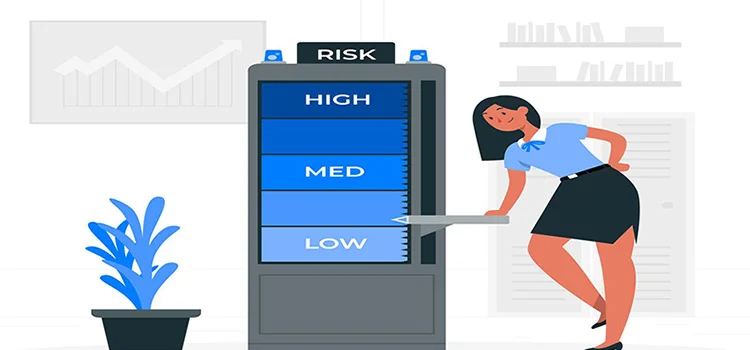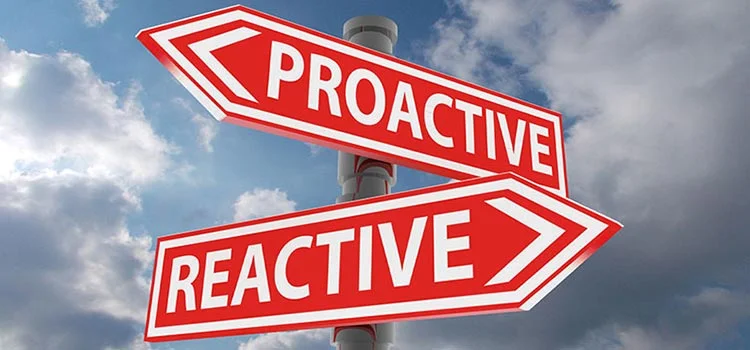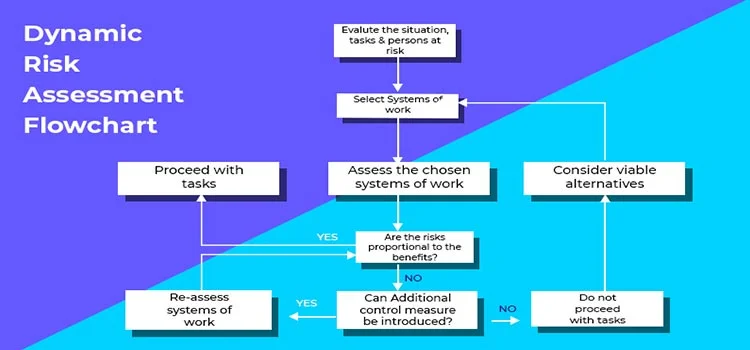Business Skills
What is a Dynamic Risk Assessment? [Complete Guide]
Risk assessment is an integral part of our life. But it’s especially vital in places where you’re responsible for the safety of multiple people. A dynamic risk assessment (DRA) is the process of continually observing and analysing risks and hazards in real-time in a changing or high-risk environment.
This is done while completing a task, so you can continue to carry out your duties safely. This allows us to quickly identify new risks before they can do any harm and remove them. They don’t replace a formal risk assessment but can complement one. It’s done in places where we need to assess any unknowns that cannot be predicted or that may change during our task.
In this guide, I will familiarise you with dynamic risk assessment. If you patiently read through the entire blog, you’ll find answers to all your questions.
Table of Content
Is Risk Assessment Necessary?
In most countries, controlling the risks in a workplace is a part of managing the business. It’s a legal requirement, not a choice.
The goal of a risk assessment is-
- To understand the potential risks
- Figuring out what people are doing to prevent that risk and if they are appropriate and sensible
- Decide whether we can do more to further minimise the risk
This process helps us remove those risks entirely or at least put in a proper routine to ensure that we can reduce them to a negligible level.
So, What is Dynamic Risk Assessment?
Emergency services are the most common areas where you’ll find Dynamic risk assessment or DRA procedures. Dynamic risk assessments provide a way to control developing and unforeseen incidents safely. It was initially introduced for fire services. But it has since been extended to situations that have the potential to evolve.
In fact, the definition is given outright in the name- dynamic, as opposed to static.
Difference Between Risk Assessment & Dynamic Risk Assessment
Formal risk assessments are prepared in advance, even before the workers start working on the premises. We record and monitor them on a regular basis. But, dynamic risk assessments are ‘dynamic’ or ever-changing. People carry them out on the spot. This is because we can’t predict the nature of dynamic risks beforehand.
However, carrying out a dynamic risk assessment doesn’t mean that a formal risk assessment is unnecessary. In fact, dynamic risk assessments complement and fill the gaps that you can’t predict when completing your standard risk assessment.
Always carry out a DRA before entering any new situation. If changes occur in the circumstances, continue to constantly assess the risks and hazards.
Are you looking for a Risk Assessment course?
Why Would I Need to Do a Dynamic Risk Assessment?
You might be wondering why you need to bother with Dynamic Risk Assessment if a standard or formal Risk Assessment process is already in place. These standard risk assessments take a lot of time, money, and effort to be adequately implemented.
But, remember, we can’t always predict a hazard or a bad situation. The nature of many jobs, particularly those that employ lone workers, is dynamic and ever-changing.
What would you rather do- spend some extra to put an in-the-moment safety net or risk some unforeseen trouble that may jeopardise the day to day operation of your business or organisation?
Life can be unpredictable. Fresh hazards can arise at any time in these situations. Suppose someone’s job role takes them to locations where no specific formal risk assessment is in place. In that case, a dynamic risk assessment will help them identify potential hazards and make essential decisions about keeping themselves and others safe. It is vitally important to make sure that you and the people you work with have safety at the forefront of their minds all the time.
So, regular risk assessments will always be a valuable, legally required part of employment law. But a dynamic risk assessment allows your staff to go further and be prepared to assess developing situations as they arise.
When Should a Dynamic Risk Assessment be Used?
Working alone, activities that are classified as high-risk or regularly changing work environments are all subject to dynamic risks.
Lone workers can find dynamic risk assessments particularly useful due to the fact they’re often subjected to environments that have the potential to be dangerous.
An electrician, for example, will be going from house to house to do their job. The factors that can pose a potential threat to their safety can be-
- Different aspects associated with each house, such as a client under the influence of substances at a home visit
- Trip hazards
- Hazardous substances
- Even pets
Emergency service workers are more likely to encounter situations where it’s crucial to assess risks and hazards quickly.
The same can be said if you deal with people whose behaviour may be unpredictable, aggressive, or abusive. Your every visit will be different, and there may be risks that you can’t predict. Think of charity workers asking for donations on the street – working with the public can present many unexpected risks. Think about the security staff operating after hours. Most roles in the defence sector are also somewhat dangerous to varying degrees.
These are all examples of jobs that are dynamic and uncontrollable by their nature.
A few questions that can help you assess the situation are-
- Do they have a history of violence, and if they are to act erratically?
- Are they under the effect of any substance, and how would the substance influence their mood?
- How comfortable do I feel in this situation, and if I’m vulnerable in any way?
- Is there any weapon that can be a potential threat?
- Is anyone else at risk?
- What is my exit strategy?
- Are my actions or words provoking the situation, or does my presence somehow bothering someone?
- Am I invading someone’s personal space?
Risk Assessment Course
This risk assessment course is accredited by the CPD UK. CPD is globally recognised by employers, professional organisations and academic intuitions, thus a certificate from CPD Certification Service creates value towards your professional goal and achievement. CPD certified certificates are accepted by thousands of professional bodies and government regulators here in the UK and around the world. | By Lead Academy
How to Conduct a Dynamic Risk Assessment (DRA)
There are various courses and providers who can train your employees on risk assessments. They’ll dive much deeper into the subject, taking a holistic approach to safety.
However, there are a few basic things that you can coach your employees on.
Assessment of New Environment & Taking Precautionary Measures
Lone workers should run a security check before or immediately upon entering a new work environment.
For example, you can do this before entering a property that is unknown to you. You should look for warning signs. Remember, we humans are incredibly efficient at identifying hazards and immediate threats. So we should always trust our gut feelings. If anything seems unusual, don’t take the risk.
But, as part of your risk assessment procedure, run a risk assessment check in a logical manner. Look at your client’s emotional state. Oftentimes, we are naturally inclined to illogical behaviour when we’re agitated or disturbed. See if they look under the influence of drugs or alcohol. If anything seems unusual, then just leave. It’s not worth the risk.
If you have a group with you, don’t enter a site without ensuring their adequate safety as well. Make sure that they are comfortable with all the safety measures that are in place. So, if you’re dealing with the security of a site, you can follow the procedures described below-
Assess the Risk at the Entrance
Get a good idea of the risks you face as soon as you arrive in a new situation. When you enter a work location- it could be a client’s home or new industrial site-
1. Look around and take a mental note of everything that you can see and everything that you can’t see. Try to guess at what could be concealed behind closed spaces by measuring its relative size, nature etc.
2. Identify any immediate hazards to you or to those with you. Hazardous objects or substances can pose varying levels of threat to different people depending on the age of your companions. If there are any obstructions, try to understand what their purpose is.
3. Consider how dangerous the site is based on your assessment in number 1 and 2.
4. Now that you have calculated how dangerous the site is ask yourself: what is the likelihood of an accident happening here?
5. Sometimes we can ensure the safety of a group in a particular place, but if that place changes, our capability of ensuring someone’s safety changes along with it. Can you make sure that you can responsibly handle the safety of not just yourself but also the group with you on that particular site?
Other People are the Greatest Threat to Us
In any situation, it helps to know who you’re going to deal with prior to a meeting with them. People are the most significant risk factor in any given situation. Always keep this in mind before placing yourself in any situation.
Whenever you deal with a person or multiple people, take note of their:
1. Appearance: For example, appearance will often give you telltale signs if you’re dealing with an active drug user.
2. Speech: For example, tone, modulation, choice of words can give us a hint of someone’s mental state and their estimation of us.
3. Body language: Never ignore the power of observing people’s body language to assess if a situation is going to escalate. Bared teeth, clenching of fists, staring aggressively- all these can tell you if someone has the potential to assault you physically.
Communicate Clearly
You should report hazards to a manager or a supervisor as soon as possible, but if you find yourself in immediate danger, you should get yourself to safety and report after the fact.
If you decide to take action to alleviate the risks, communicate your decisions and new procedures clearly. Ensure that people understand what is happening and are aware of your actions and why exactly you are doing what you’re doing. Also, it’d be wise to hear any alternative solutions, should there be any, from the people in your group and calculate its viability.
Be Proactive
You need to assess the level of risk involved instantly. Taking too little time to assess everything involved in your situation or taking too long in the same case- both are unwise as long as safety is concerned. How you should proceed is dependent on your assessment of the situation.
If there has been a formal risk assessment for the particular setting where you are right now, is it still valid in this context? Will it be wise to proceed?
Don’t ever hesitate to take precautionary actions against a risk. Any sensible company will organisation will prioritise the safety of its employees over everything else. The only exception here is if the risks involved are so negligible that even the employees themselves are entirely comfortable with it.
Exit Strategy
You should always have an exit strategy in any workplace. This is especially true if you’re a lone worker.
Always check, then double-check where the doors are in the given premise, where the emergency exits are. Also, look for obstructions that may prevent you from making a swift exit when you need to.
Instinct
This ties in with the “gut feeling” that I spoke about earlier. There are many recorded incidents where people calculated before an attack on them that they were not safe. Coach your employees not to take risks and encourage them to not worry about the aftermath of leaving a potentially dangerous situation.
The only aftermath to consider is that they have averted a potential accident. It’s not worth it for a company, organisation, or employee to risk an accident or something similar for a little bit of setback.
If something doesn’t feel right, it probably isn’t. Exploring the possibility of the situation being not as severe as initially thought to be is not a smart choice by any means.
Record and Forward Your Findings
We should document and record all stages of the Dynamic Risk Assessment to help improve safety measures in your workplace and identify warning signs. Technology plays a prominent role in making the DRA process repeatable and helpful in enabling safe systems.
In the case that a situation happens again, you’ll have a point of reference on where to begin. A record to check on similar incidents of the past and what was done to mitigate the incident when anything goes wrong will be a tremendous help for the people involved in finding a solution.
If you cannot make a complete record of the incident immediately, just take notes and make a record from the notes afterwards.
Gain Access to Additional Training if Possible
Wherever we go, the chances are that we’re already carrying out risk assessments in our heads.
But dynamic risk assessment involves taking a professional and responsible approach to hazard awareness. It also teaches us how to minimise the risks. If we have no prior experience on how to handle a particular situation, the outcome doesn’t always turn out to be the best.
This is where accessing additional training to help your staff develop these crucial in-the-moment decision-making skills comes in handy. Any kind of training, even ones that explain risk assessment in a descriptive way rather than showing it practically, will be a big step forward.
Isn’t this Just Common Sense?
It definitely is, but only to a certain degree.
We’re good at making bad decisions. That’s why spending some extra to train employees so that they’ll actually use their common sense is something that is necessary.
According to The Health and Safety Executive (HSE), 32.5 million working days were lost in the UK due to accidents, long-term injury and ill-health during the 2019/20 period.
Unless we coach people in using their instinct and common sense to be aware of their surroundings and the potential risks they face, they likely won’t use these skills. Most of us don’t walk around looking for the danger in everyday situations. So we don’t tend to be on alert most of the time. But if something were to happen because of our complacency, it’s, in fact, not worth the lost company time.
Coaching employees in dynamic risk assessment could also contribute to the overall safety culture within your business. Trained employees are more likely to be vocal about safety, good at identifying risks, and positively influence others.
Your organisational messaging also have to be parallel. Make it clear to employees that safety comes first- before deadlines or targets. If they remain under the impression that their company or organisation will pressure them for their work even with some potential risks involved. In fact, their “gut feeling” or their natural instinct may even give them mixed messages under these circumstances. You’ll have to clear these confusions.
Thus, dynamic risk assessment training will give the workers the confidence to be able to take the most logical decisions under any circumstances.
Check out our other blog if you ever wish to become a health and safety officer.
Structured Approach to DRA
Take a look at the flow chart from SafetyCulture below. It’s a structured approach to DRA that UK Fire Service Resources (UKFRS) originally made.
Although variations exist from workplace to workplace (like the one developed by the National Fire Chiefs Council), it’ll give you a general idea on how DRA works once a company or organisation makes a structured DRA approach that suits them the best.
Benefits of Dynamic Risk Assessment
Understanding how to carry out a DRA has many benefits. If you work in constantly varying environments, DRA is a vital part of your job.
If you train in DRA, you’ll be able to-
- Take Proactive Approach to Safety
An untrained person may escalate even a simple hazardous situation to a serious one just because they panicked or doesn’t know what to do.
- Be Confident in Your Ability to Assess Your Environment
When you have the appropriate training needed to instantly analyse and react to risks and hazards in any situation, you’ll feel confident making decisions that ensure your and your team’s safety.
- Do Your Job in Complete Confidence
When you have the skills you need to do your job safely, you’ll feel more confident entering situations where you have little or no control over safety.
Conclusion
Beware that a dynamic risk assessment should never replace a standard or formal risk assessment. It complements a good formal risk assessment, sort of like a tool. Educating your workers on using this tool and all other standard safety measures will equip them to face all eventualities.
This is why dynamic risk assessment is so valuable to lone workers and small teams, as they’re the ones who face the ‘dynamic’ aspect of their job role most often.
Although this guide will give you a general guideline on dynamic risk assessment, still it’s best to enrol on a risk assessment course that will dive much more deeply into the subject and everything associated with it.
What to Read Next:
- 20 Jobs to Consider if you have Good Communication Skills – Details and Overview
- How Many Steps are There to a Risk Assessment?
- What is the Purpose of a Risk Assessment








